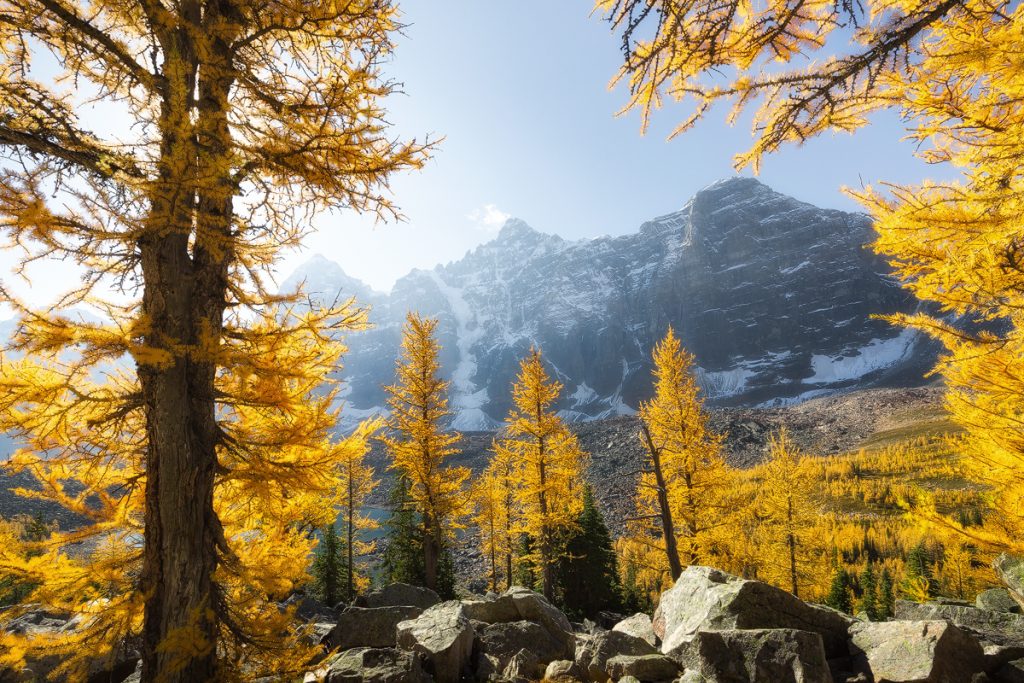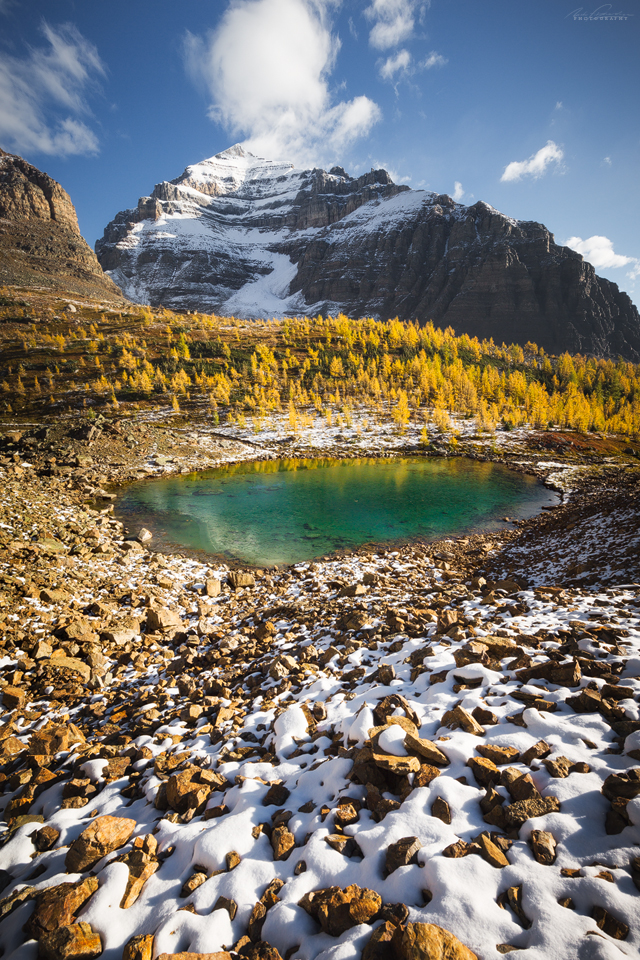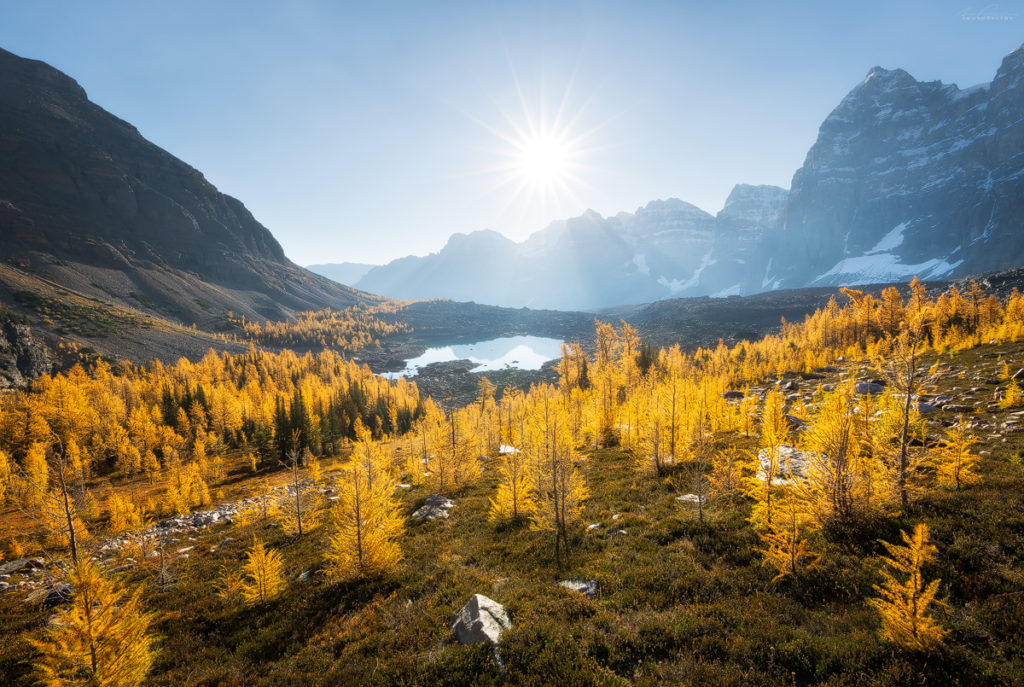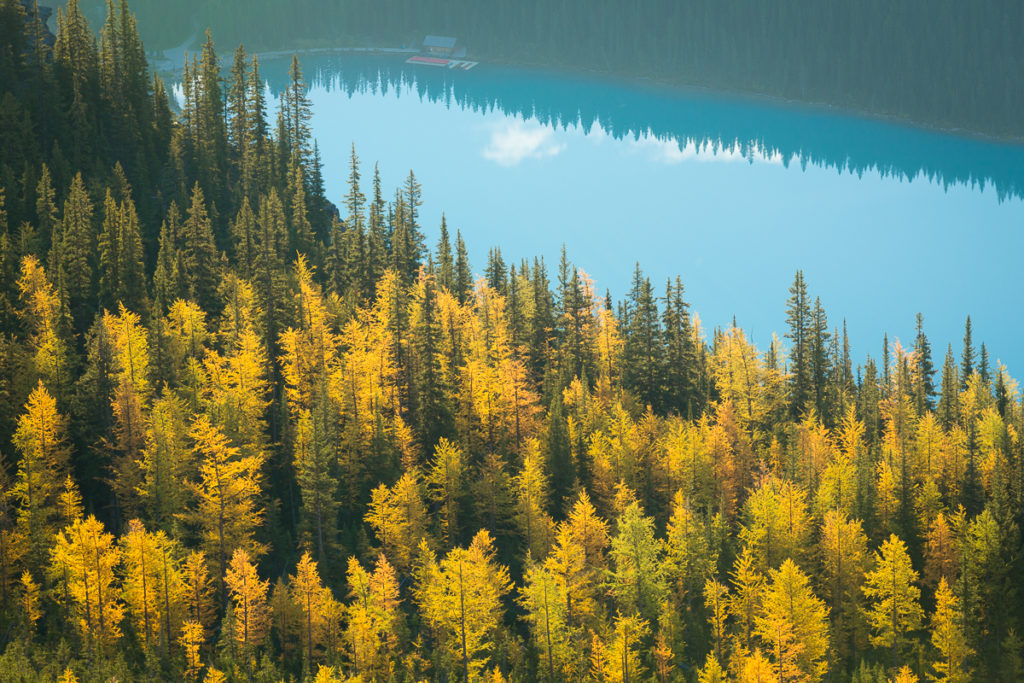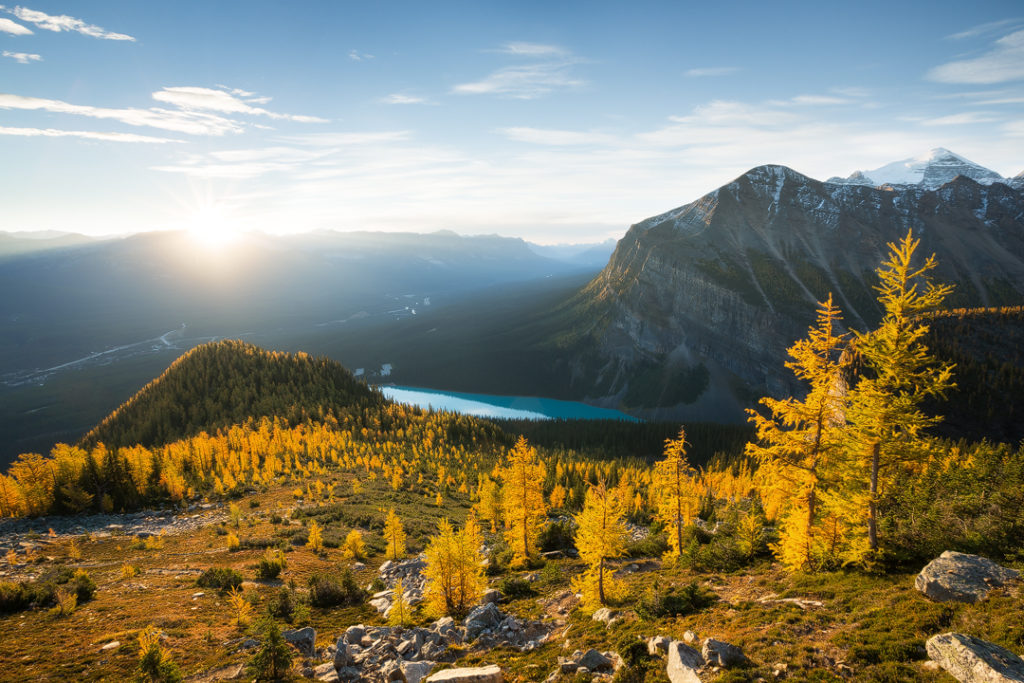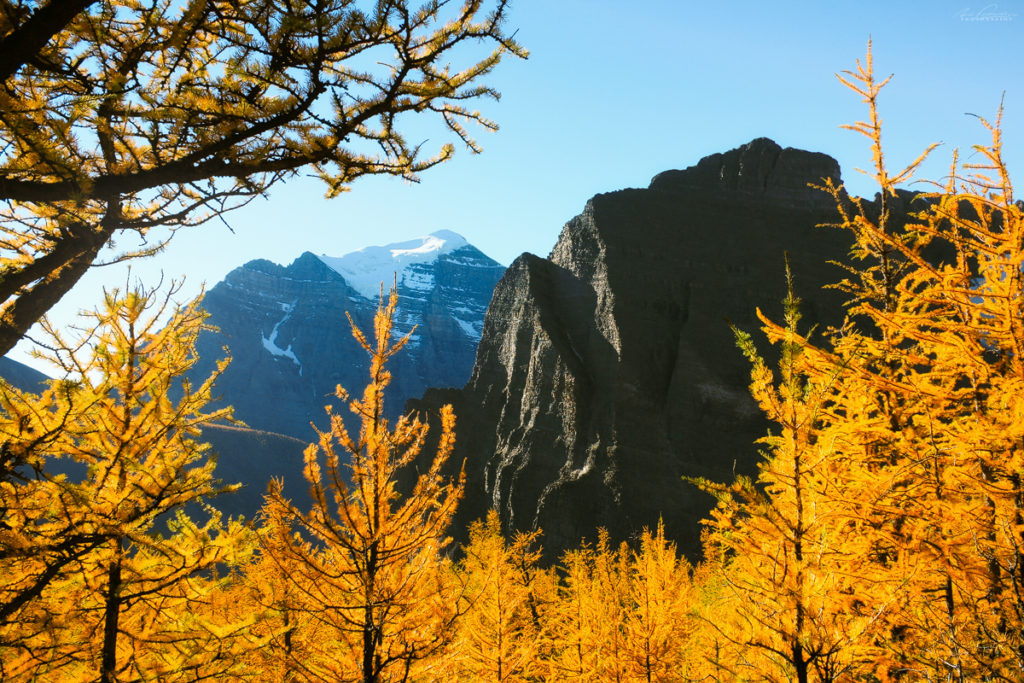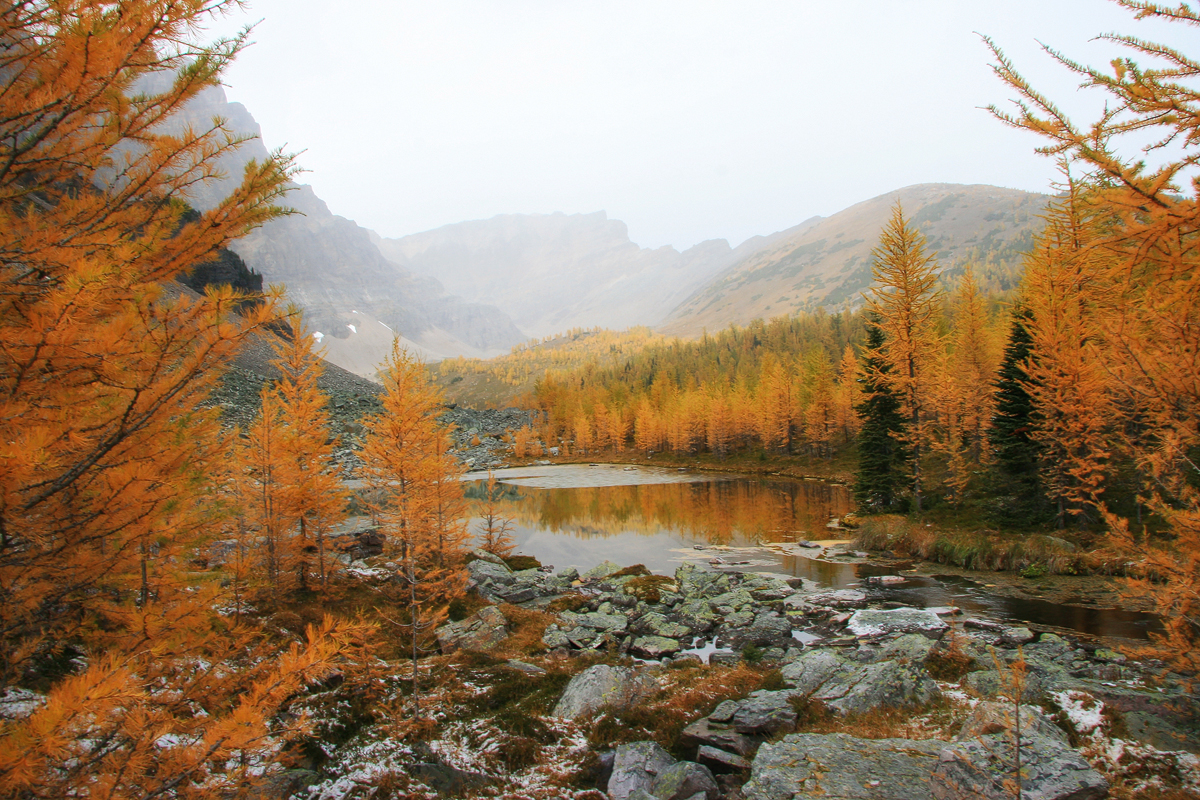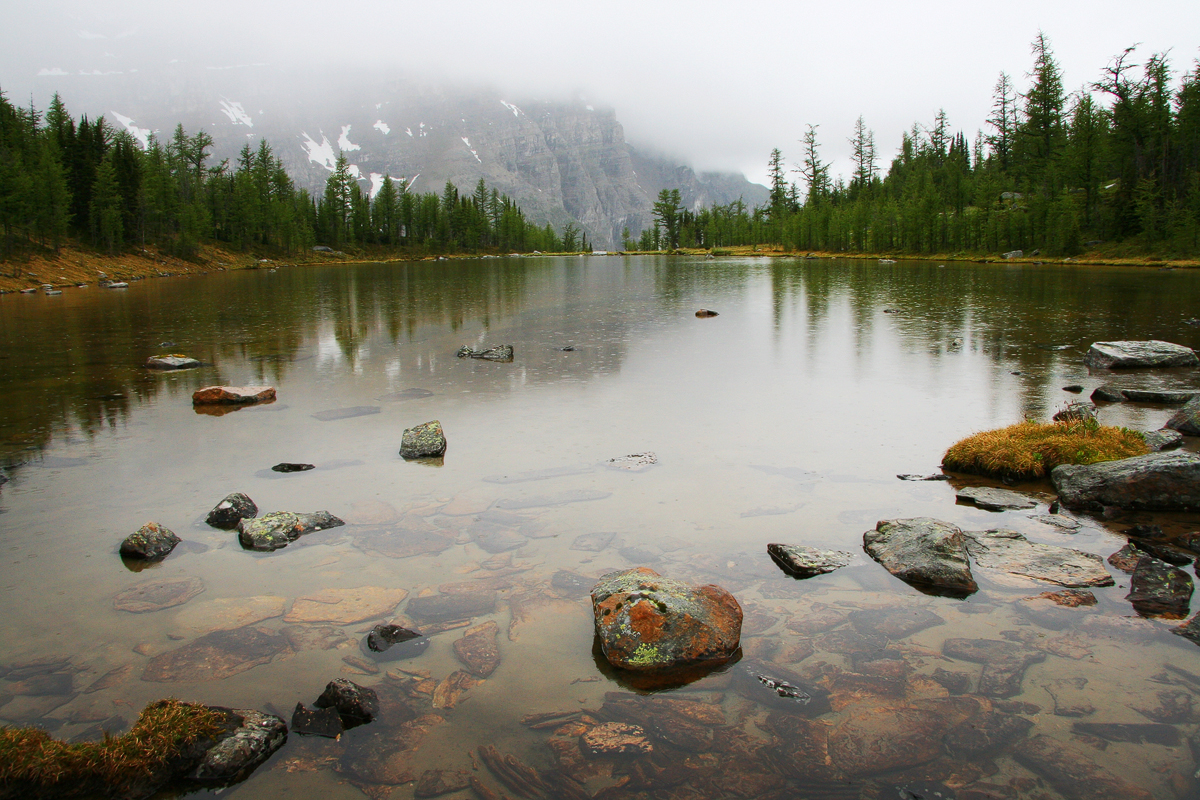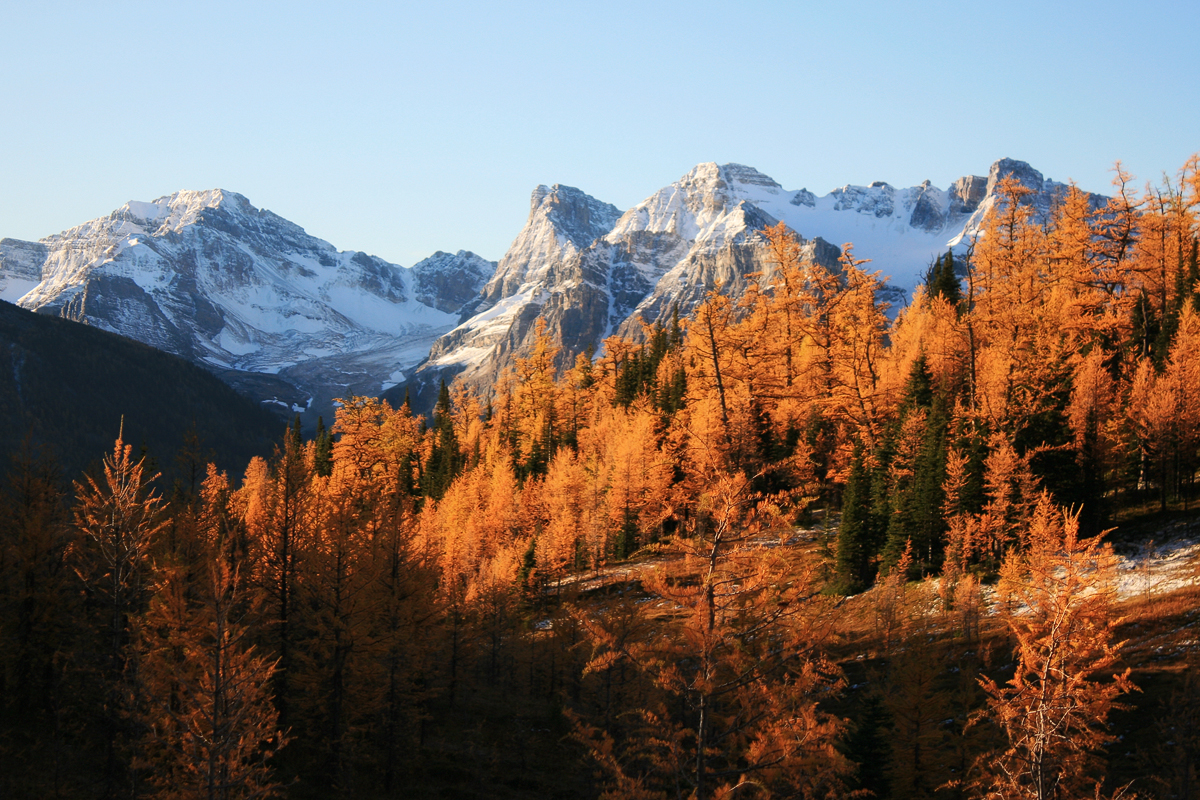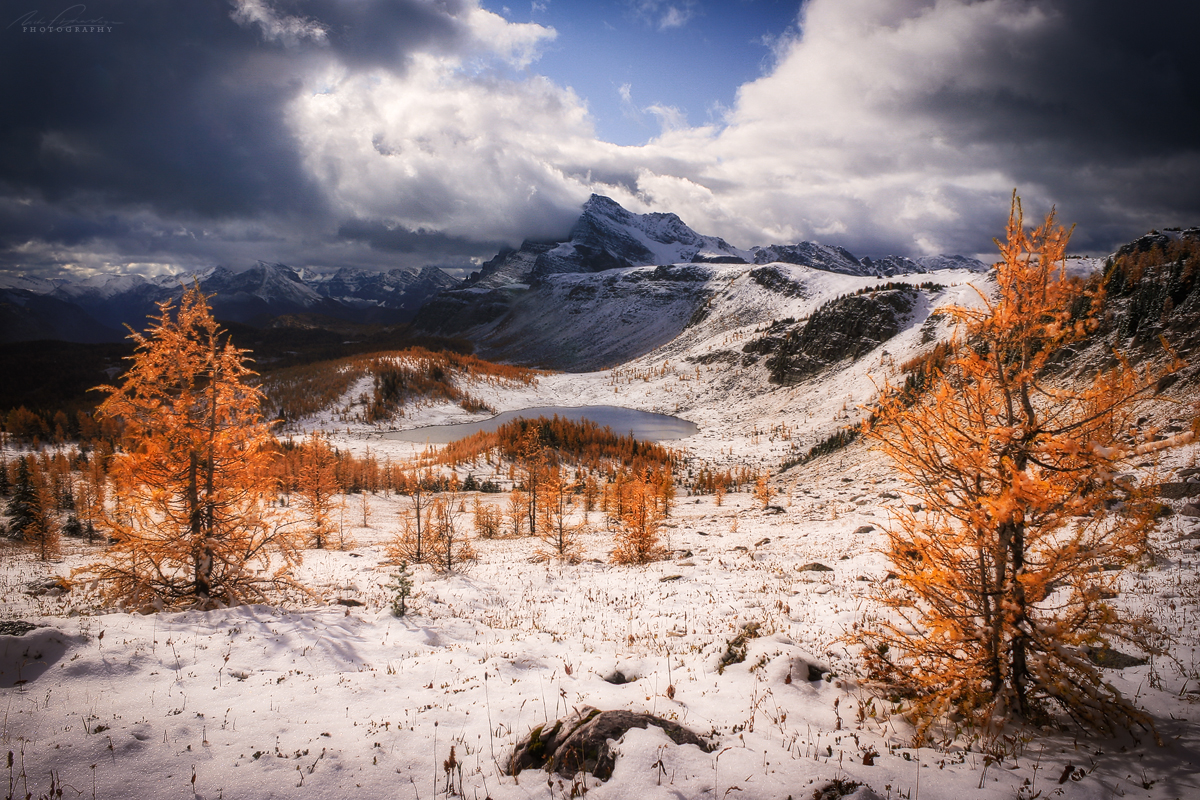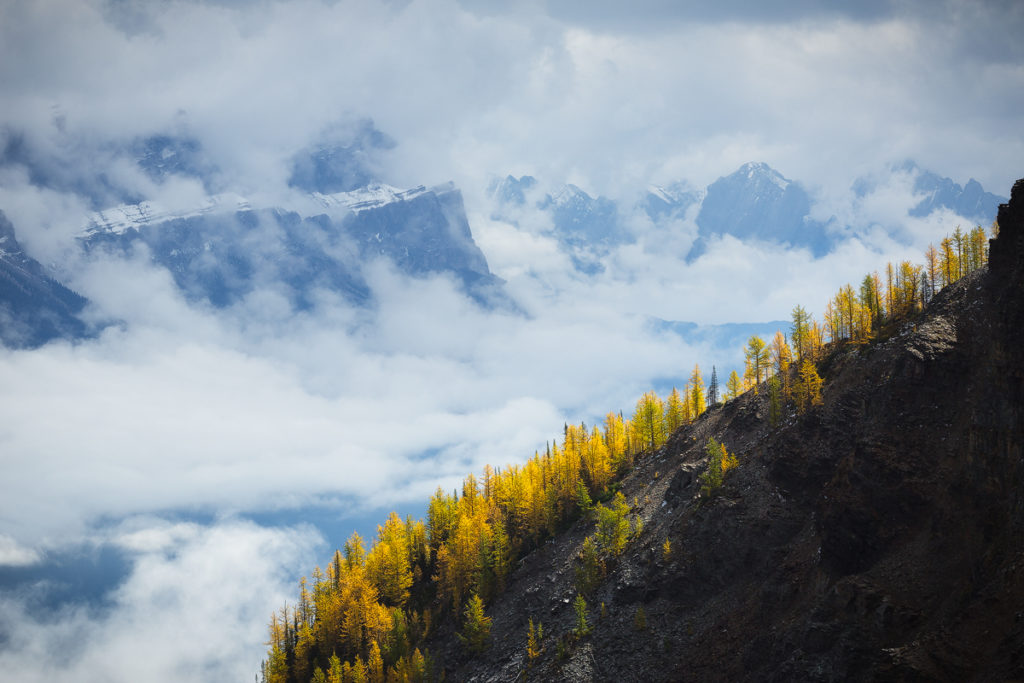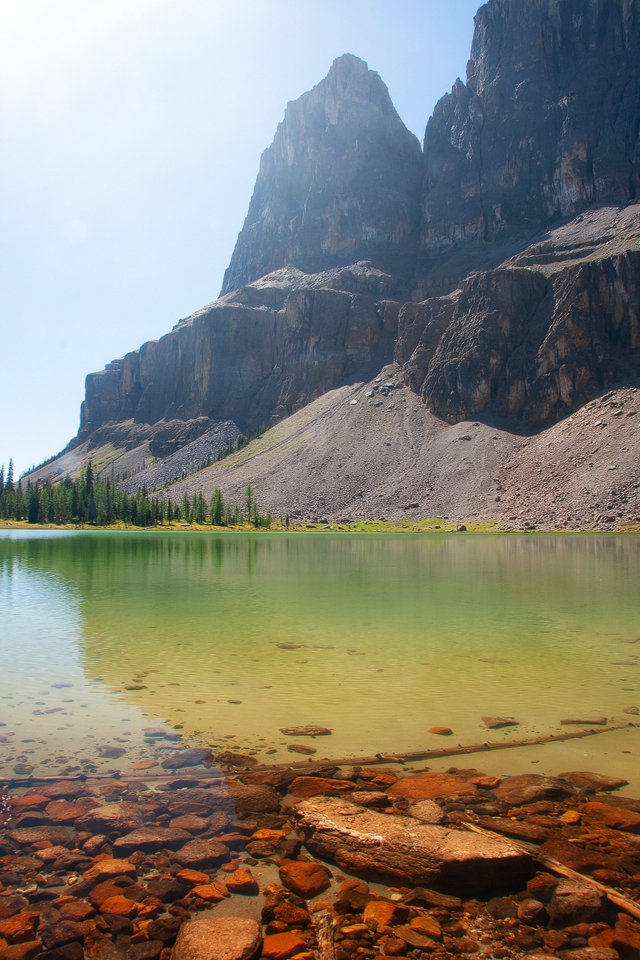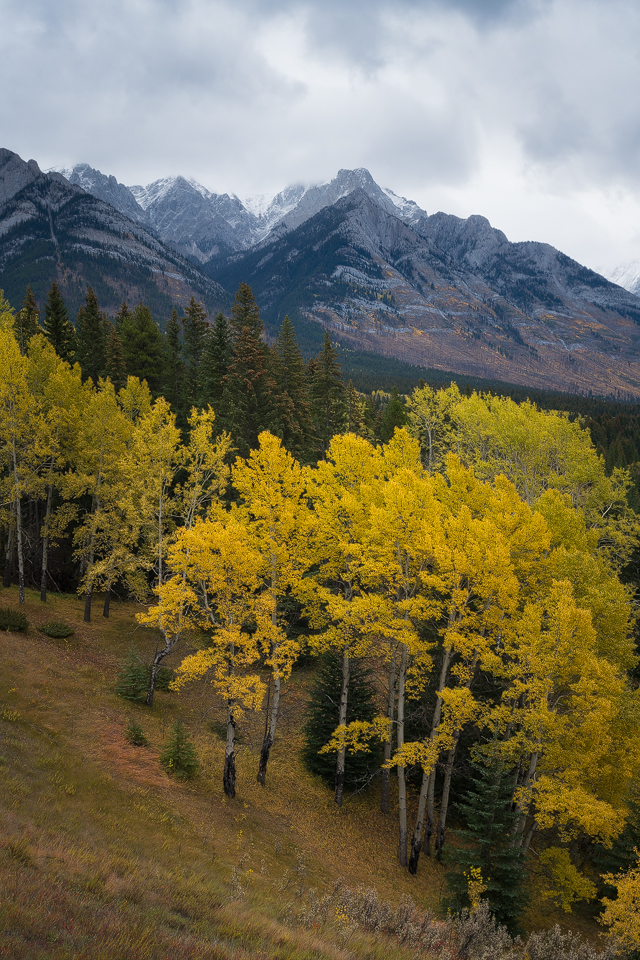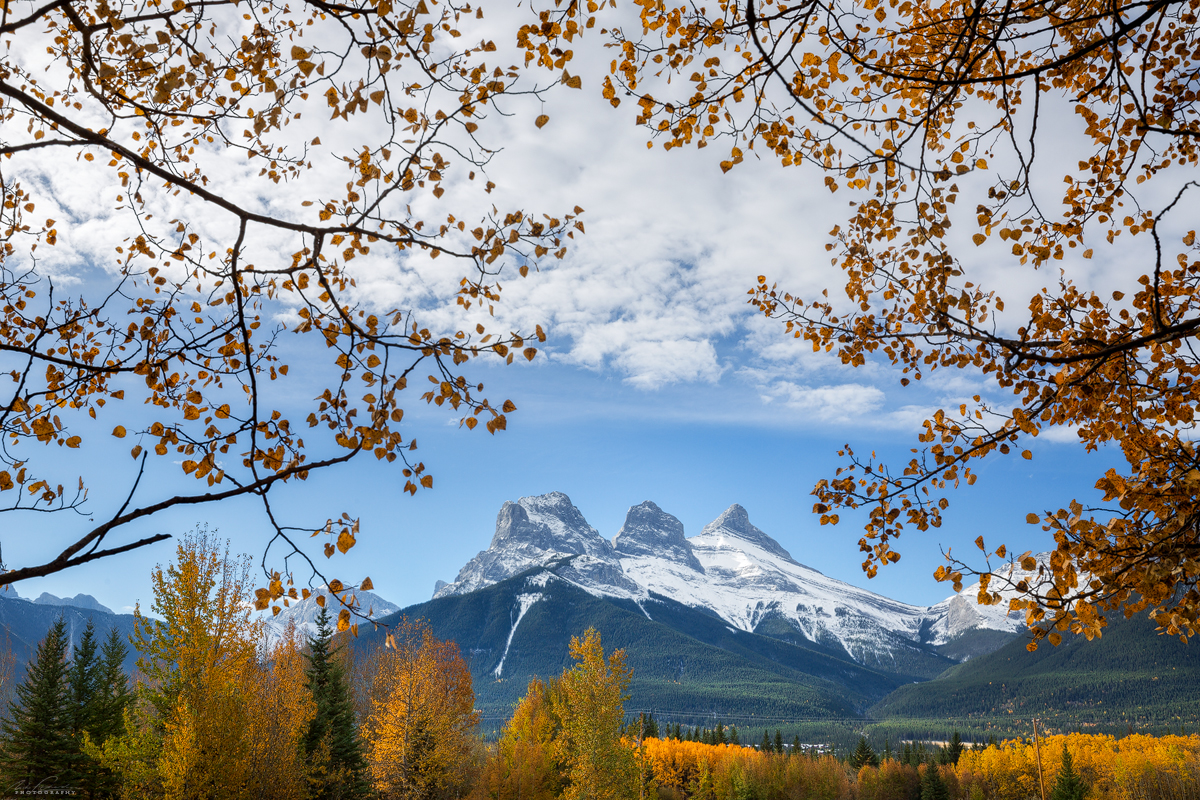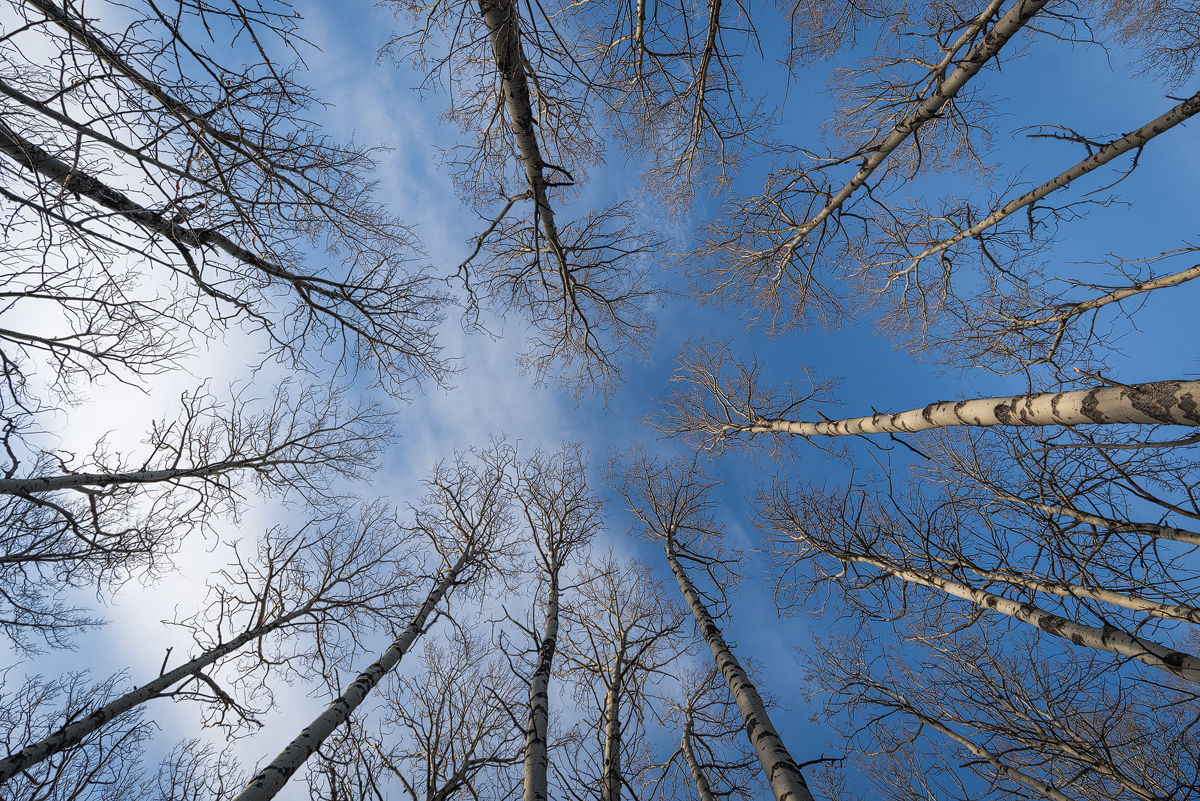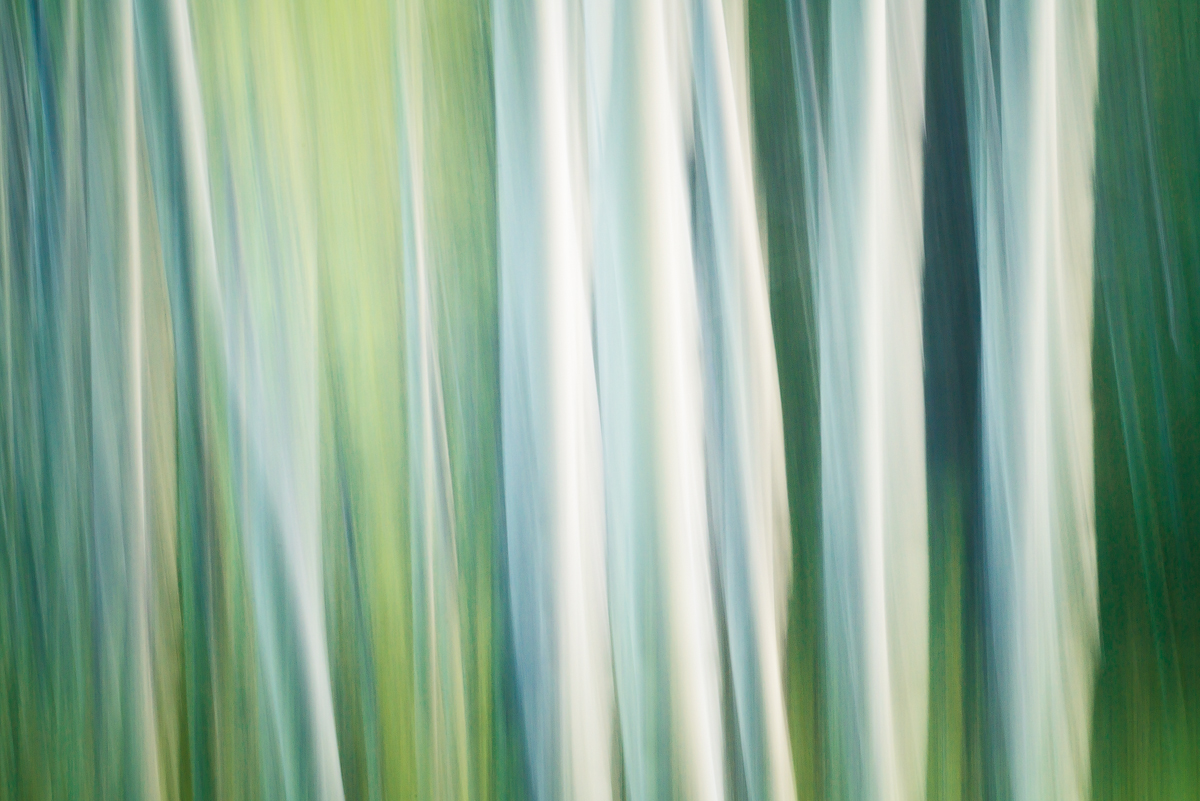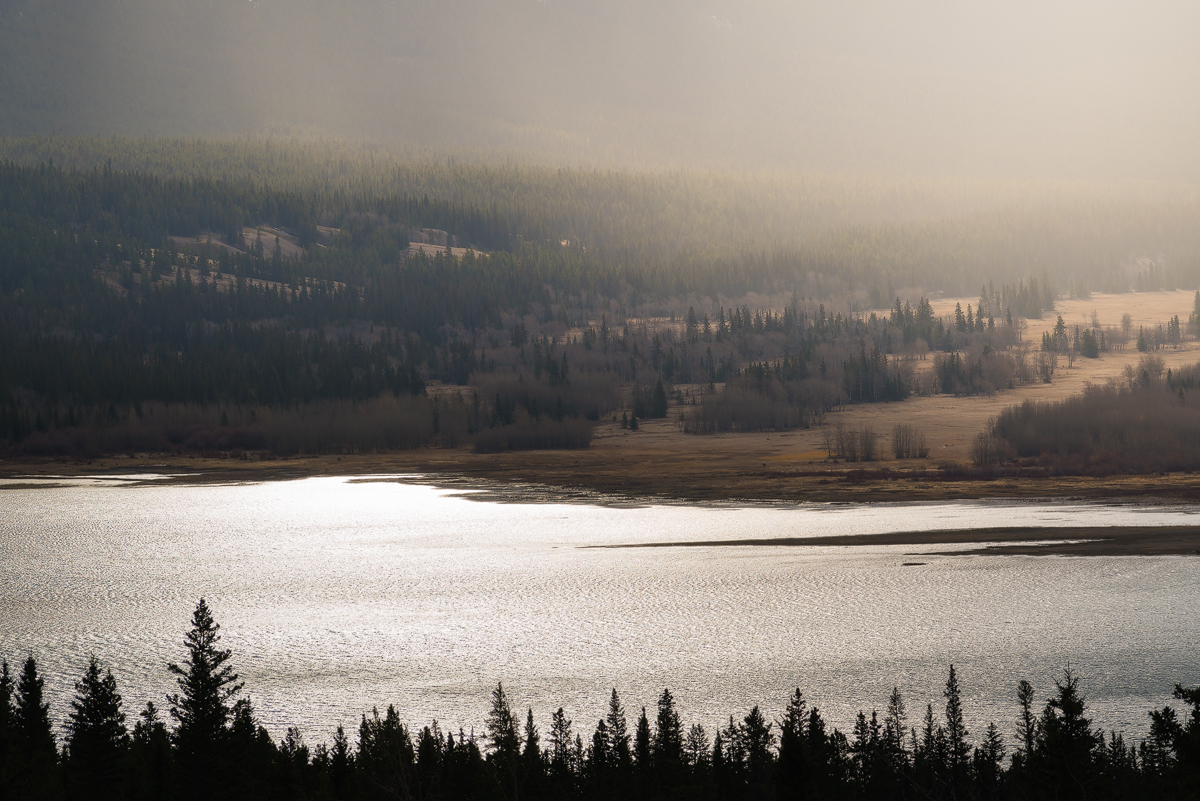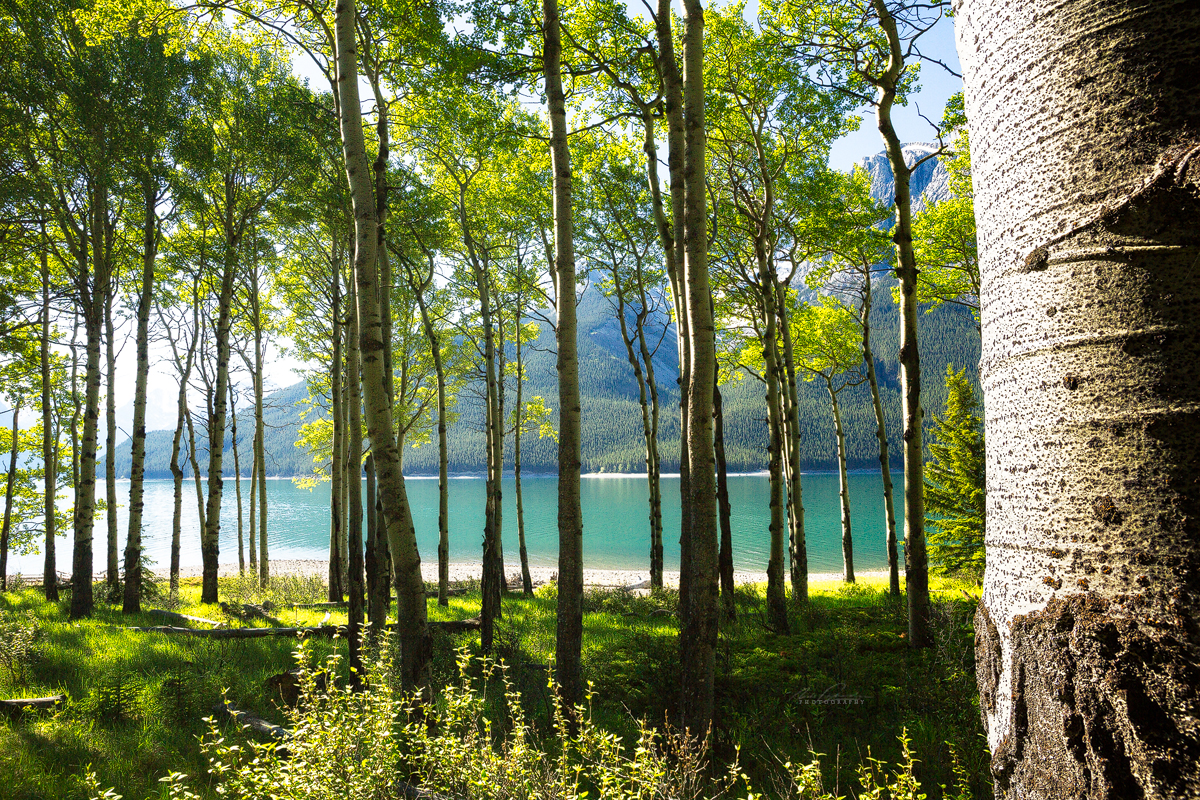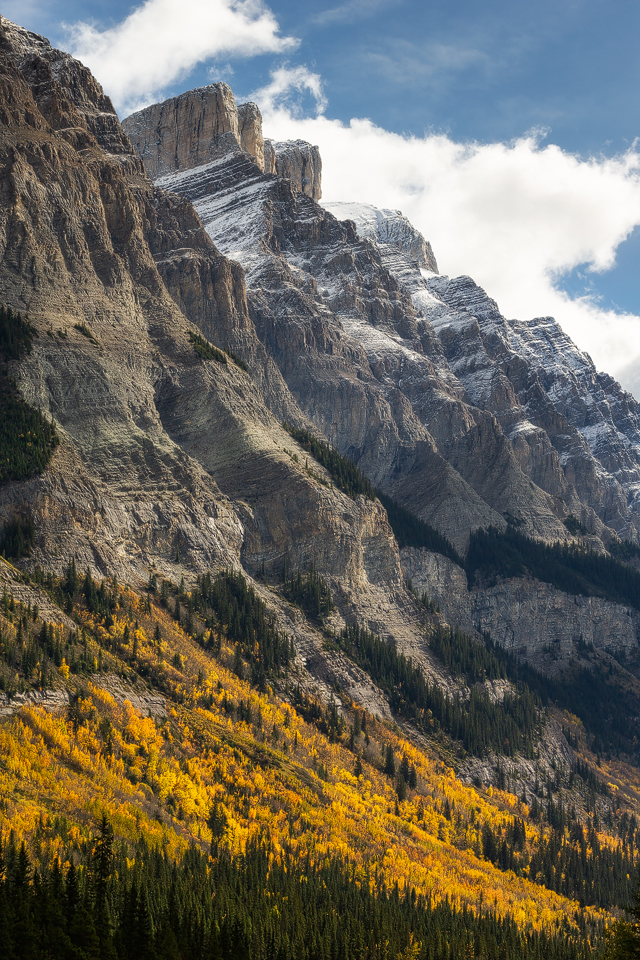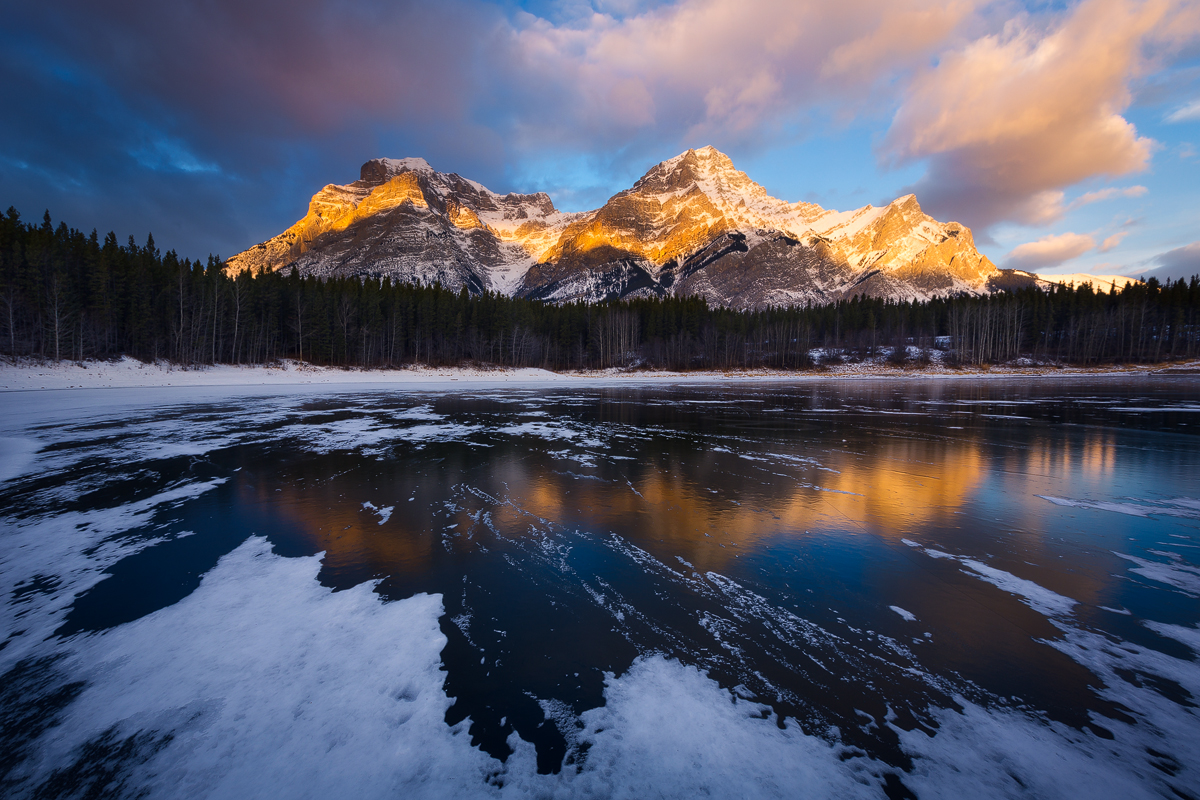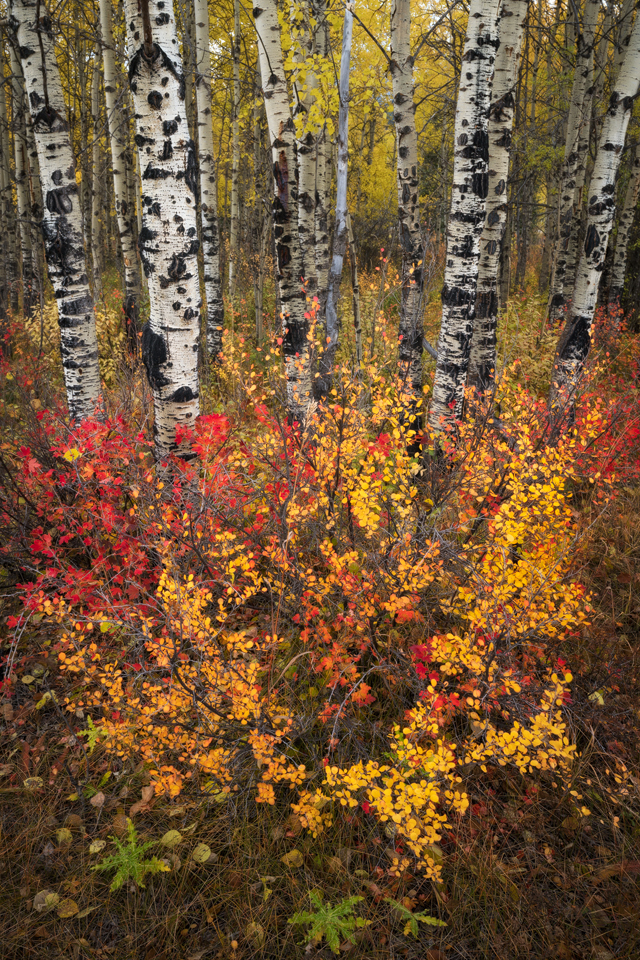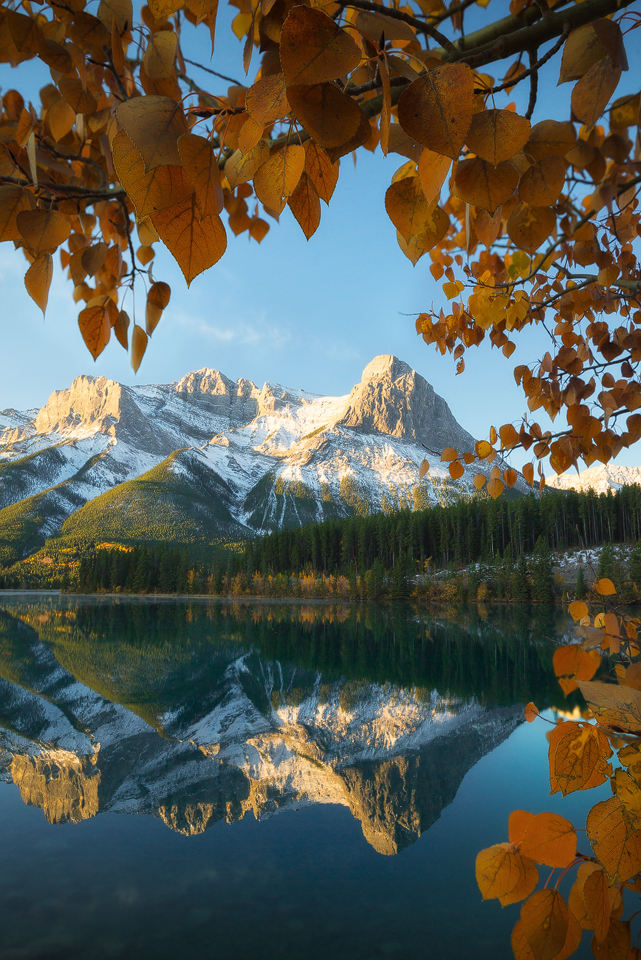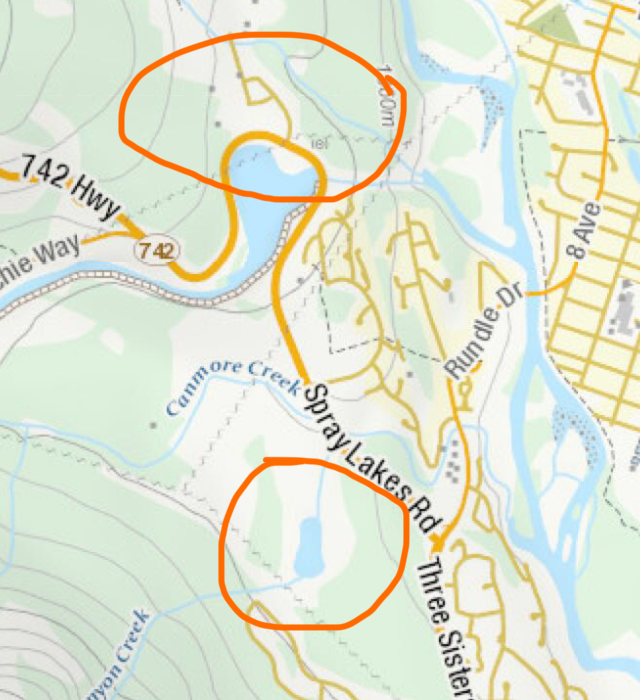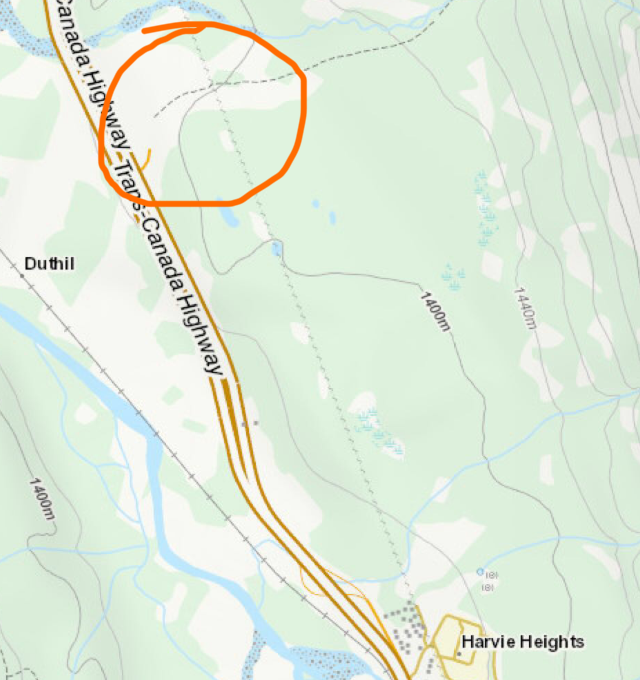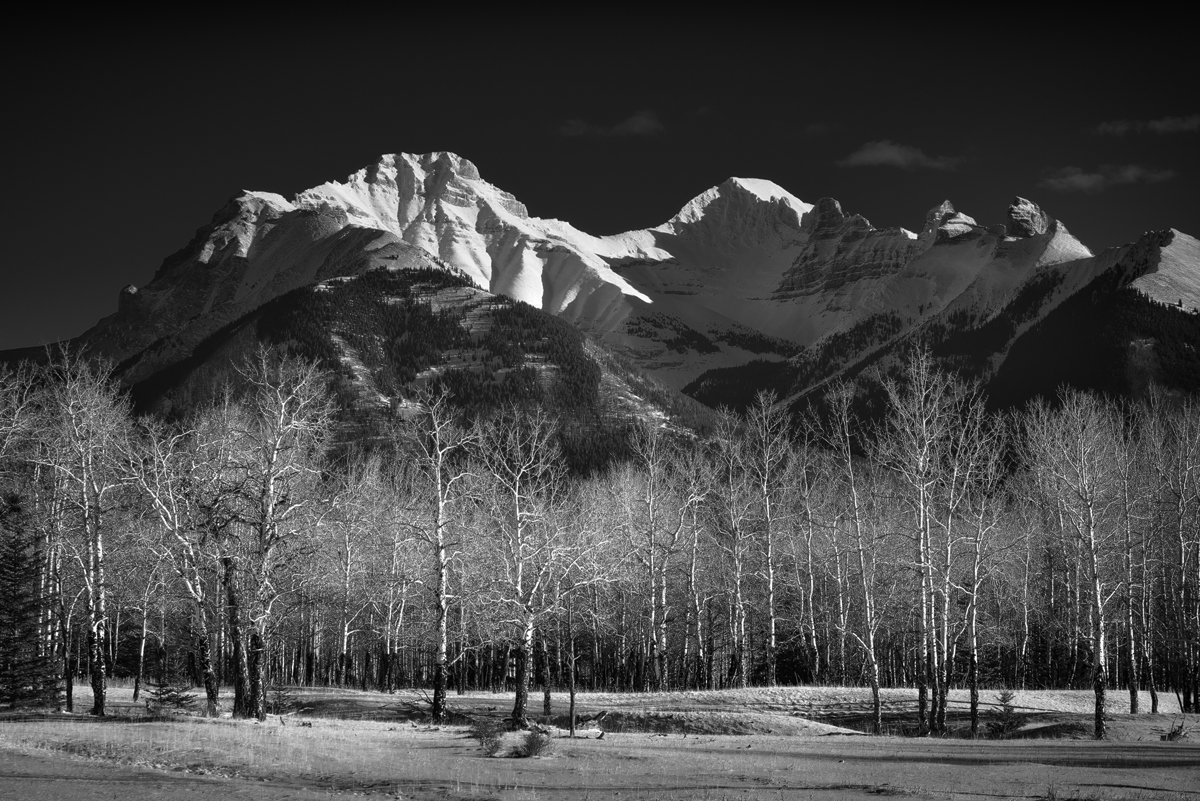Fall in Banff National Park offers some great opportunities for landscape photography, particularly from mid-September to mid-October. This is my favourite time to photograph in the Canadian Rockies. Read through this fall photography guide to Banff for some information regarding where to go to find the best locations to photograph in the area! If you want to take some of the guesswork out of it then I offer multiple photography workshops at this time of year which include all accommodation and transportation. Get in touch using the form below for more information or to make a booking:
The reason this is the best time to visit the Canadian Rockies for photography is that you often have freshly snow capped peaks, the ability to access areas higher up in the alpine, the lakes remain unfrozen with their glacial coloration, and of course the splashes of yellow and orange of the alpine larch needles or trembling aspen leaves. This colour is not as widespread as it is in Eastern Canada where Maple trees predominate, or even as in a similar mountain environment like Colorado in the United States. It is more like a treasure hunt here in Banff National Park and you often have to strap on a backpack and take a hike to reach the most picturesque fall photography spots. Rather than recommend an exact spot I like to recommend areas which allow you to explore a little more and find your own unique take on the environment. I’ve found this more rewarding & productive not being tied to a particular spot or shot that you might have seen before.
Weather is a big consideration at this time of year before you set out. You need to be prepared for the possibility of walking through snow underfoot, colder temperatures, and less stable conditions. It is worth it for the photographs you will take and who knows maybe you will score the perfectly clear fall day in Banff! More information on the Banff weather can be found here.
My recommendations for the top 10 places to visit & photograph in the Banff area during the fall season are outlined below depending on if you are chasing the alpine larches (more hiking) or the trembling aspens (less hiking). The maps provided are just a quick rough guide, not for actual use.
Banff ‘larch madness’ fall photography guide
The alpine larch tree (larix lyallii) thrive in sheltered North facing basins between 1800-2400m above sea level. This means they are going to take a bit of work via hiking to go and photograph but its worth it! They are a resilient tree that has soft needles that turn yellow in the fall and then drop off each season. It’s an extremely short lived display that is prone to being cut short or accelerated by the wind and cold. I’ve found September 20-30th in the Banff area seems to be ‘peak’ but the higher up they are the earlier they turn so you can have different peaks according to elevation too – go higher earlier in the fall (closer to 2400m), and lower (closer to 1800m) later in the fall is my suggestion. Also, I’ve photographed them well into October but access becomes harder as snow starts to build up where they grow. Eventually they start to turn orange, then brown, before dropping off – sunlight at these late stages is key to making a photograph that could appear as though it was taken during the peak color. You will notice below that most of the best locations to photograph the alpine larch are around the Lake Louise area here in Banff National Park.
1) Larch Valley & The Valley of the 10 Peaks
If you only have time for one hike in fall in Banff National Park then make it this one. Beginning at Moraine Lake car park, hike uphill through a number of switchbacks until you reach a fork in the trail (~40min). Left continues on towards Eiffel Lake and the Valley of the 10 Peaks, right takes you into Larch Valley. If you have time visit both. Go early as it will get crowded here and I’d highly recommend taking the shuttle as parking is limited. I also recommend walking beyond Eiffel Lake towards Wenkchemna Pass to beat the crowds. The larch trees thin out but the views are stupendous.
2) Little Beehive, Big Beehive & Lake Agnes
One of the best locations to photograph the larch trees is nestled right above Lake Louise in Banff National Park. Start at the Lake Louise car park and follow the signs for Lake Agnes around the right hand side of the lake. It’s all uphill (you will notice a trend with photographing the larches – you will always have to put in the work to get there). Just before Lake Agnes split off to the right and follow signs for Little Beehive. Continue on past Little Beehive up towards Mt St Piran for an even more spectacular view of the fall color. The shores of Lake Agnes are lined with larches and the Big Beehive rising on the left of the lake is filled with them, perched on every imaginable ledge. Head for the back of the lake after a tea/snack at the Lake Agnes teahouse and then uphill onto the top of the Big Beehive. If you wish for more adventure and mind boggling views of the larch beneath your feet then explore an off trail option to the top of the Devils Thumb but prepare yourself – I encountered a grizzly bear hunting a mountain goat up there last fall. Bear spray is an essential item for all of these fall photography suggestions as the bears are active in the alpine at this time.
3) Saddleback Pass
A short but steep hike beginning at the Lake Louise shoreline near the canoe dock traverses around the front of Mt Fairview (the mountain on the left when looking down Lake Louise at the iconic view from the Chateau Lake Louise) and up into Saddleback Pass. Spend time immersing yourself among the larch trees which flow up either side of the pass and if you have the extra energy a detour to the top of either Mt Fairview or Saddle Mountain is recommended. Saddle Mountain in particular has my favorite unobstructed view of the glacier capped Mt Temple across on the other side of Paradise Valley. Bring both your wide and telephoto lenses – the latter will allow for some stunning compression of the yellow larches against the background peaks.
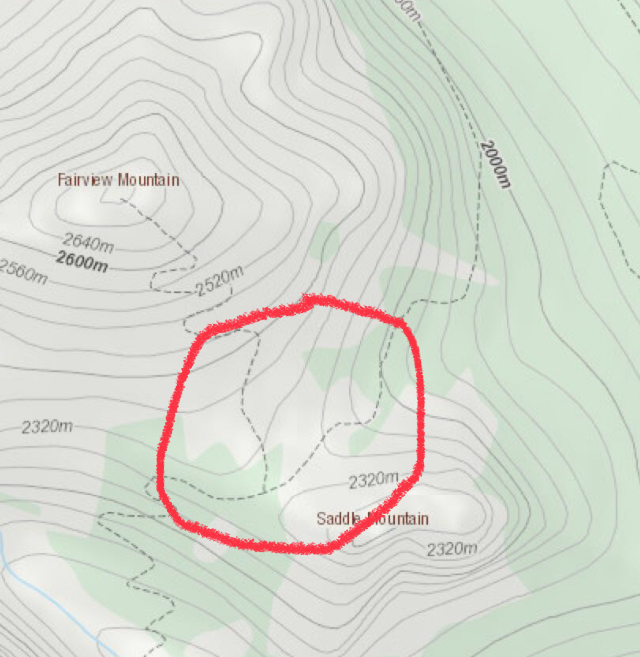
4) Hidden Lake & Skoki Lakes
Beginning near the Lake Louise ski resort (follow the side road on the right immediately before the resort a short ways to a car park) you begin the trek into the Skoki region. It is one of the premier year round destinations in the Canadian Rockies – Skoki Lodge is a National Historic Site and was the first backcountry ski lodge in The Canadian Rockies. At first you follow the ski out/dirt road up and around the back of the ski hill. Once you pass under the ‘Larch’ chairlift watch for the beginning of a forested trail marked by signs to ‘Skoki Lodge’. Before long you will pass the Halfway Hut and the turn off to Hidden Lake. Larches line the slopes, hopefully glimmering in the sun. Camping is available here at the turn off for the lake (book this prior to your trip through the Parks Canada website or in person at a visitor centre) and allows for a more thorough exploration. If you are continuing on ahead lies Boulder Pass and Ptarmigan Lake. My recommendation is to leave the marked trail as you traverse the far shores of the lake and head uphill into a gentle pass called ‘Packers Pass’. From here the Skoki Lakes (Myosotis & Zigadenus) appear below in a sea of larches with the Wall of Jericho slicing down into them behind. You could spend days here so prepare for the visual overload with enough time and arrange camping nearby or at the lodge. The trail system from Skoki Lakes to Skoki Lodge is a maze of lakes, waterfalls and ledges that will leave you shaking your head once again at the beauty in the construction, & erosion, of The Canadian Rockies.

5) Taylor Lake & Panorama Ridge
Park in The Taylor Lake car park between Banff and Lake Louise. Its about 6km uphill on a nice forested trail to the edge of Taylor Lake which is dotted with larch trees. If you need more yellow in your frame then follow the trail (turn off is just before the lake) to the right up into meadows below Panorama Ridge. There are small streams which can be followed to tarns here and extreme amounts of larch. Explore the meadows and up onto the gentler slopes of Panorama Ridge as the trail disappears. An excellent option for a quick fix of yellow slightly closer to Banff than the above options.
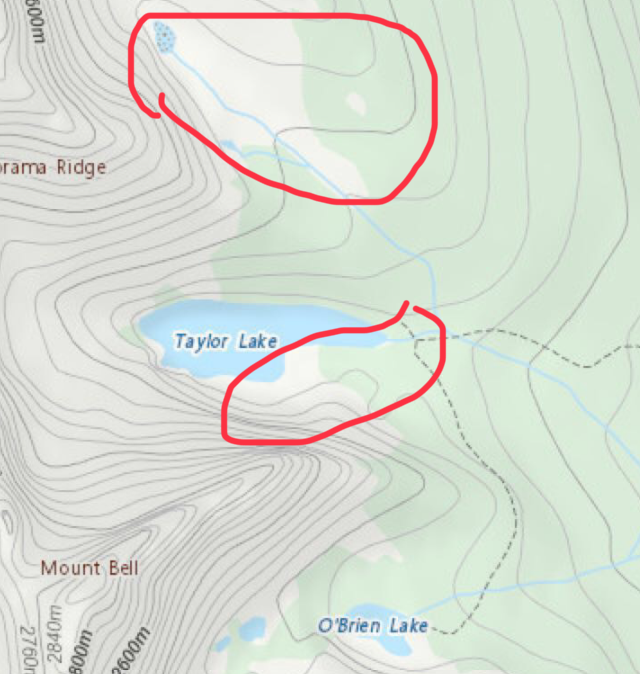
6) Upper Consolation Valley
Access begins at the Moraine Lake car park following the Consolation Lakes trail to the edge of the first Consolation Lake within 45 minutes (2.4km/slight uphill). From here rock and boulder hop around the first lake on the right hand side, then pass between the two lakes and onto the left hand side of the second Consolation Lake. A faint trail exists here. Great photo opportunities at the front and back of the second lake (my preference when shooting these lakes, instead of the rocky terrain you reach at the end of the maintained trail at the first lake). Once at the back of the second lake find a faint trail that follows the lateral glacier moraine up until fading out where you can then merge into the Upper Consolation Valley meadows. This is all off trail now, and prime grizzly bear habitat (in fact you may even be required by law to be hiking in a group of 4 as is the norm in the Moraine Lake area when grizzlies are present in the area – check before setting out on the Parks Canada website otherwise the sign at the beginning of the trail will let you know). This is definitely an adventurous suggestion requiring route finding skills but the tarns and larch trees up in this area are just phenomenal. If you make it, you will be one of the few to experience this area each year in a bustling Banff National Park!
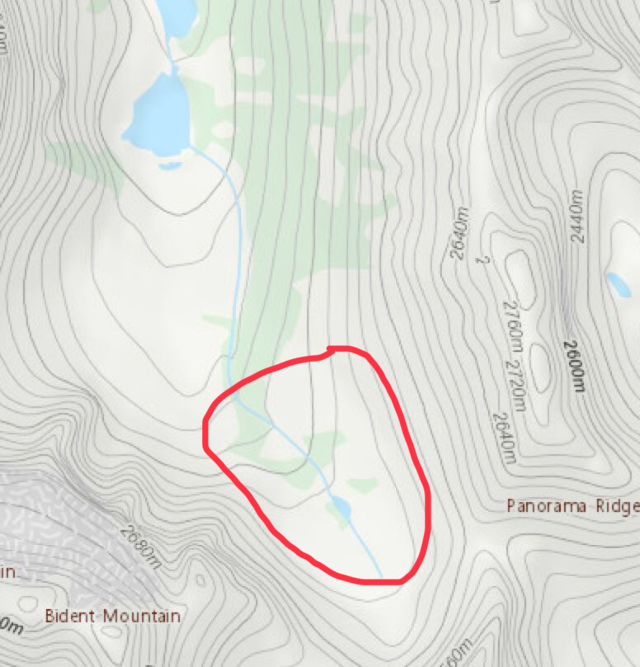
6) Gibbon Pass, Twin Lakes & Arnica Lake
These three locations located in a row beneath Storm Mountain in Banff National Park will likely require some backcountry camping to properly explore although a day trip is possible. In fact a loop of Arnica and Twin Lakes if you have two cars is a great option for a day hike. Use the Shadow Lake, or Twin Lakes campgrounds as your base if you plan to spend more time here. Three different access points exist, so research your approach – if you have the time I suggest overnighting at Twin Lakes and then heading up to Gibbon Pass early. The highlight for me here is morning light at Gibbon Pass which is packed with larch trees (pictured above), or staring up at Storm Mountain from the Twin Lakes campground. Bring an ultra wide angle lens for that! These locations aren’t readily found on the social media circuit so expect to be surprised and to come away with something unique as others flock to Larch Valley during the small window of peak larch color. If you have a spare night or two link it up with the next suggestion for a rollicking, quietly amazing, larch backpacking traverse of just over 50km. Lots of (worthwhile) up and down!
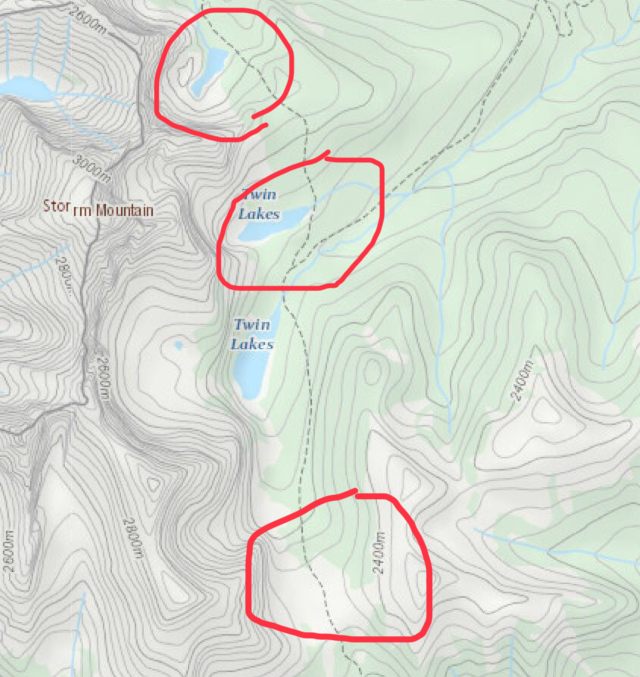
7) Healy Pass, Scarab Lake & Whistling Pass
Two of my all time favourite destinations for larch trees are Healy and Whistling Passes. Sandwiched in between is the perfectly situated Egypt Lake from where you can hike to many other lakes ringed with larches (Pharoah, Black Rock, & Sphinx, or Scarab & Mummy). Start at Sunshine Village ski resort car park and follow Healy Creek trail to reach this area. It is well worth hiking to the far side of Scarab Lake for the view back onto Pharoah Peaks, scrambling up the Pharoah Peaks should conditions allow, or looking off the other side of Whistling Pass at Mt Ball. I can only imagine what these views look like with edge of the day light because they were stunning when I visited in mid day conditions. Camping at Egypt Lakes in a tent or in the cabin is essential for full exploration of the area. Otherwise if you only have a day, a return day trip to Healy Pass is worthwhile in itself (pictured above).
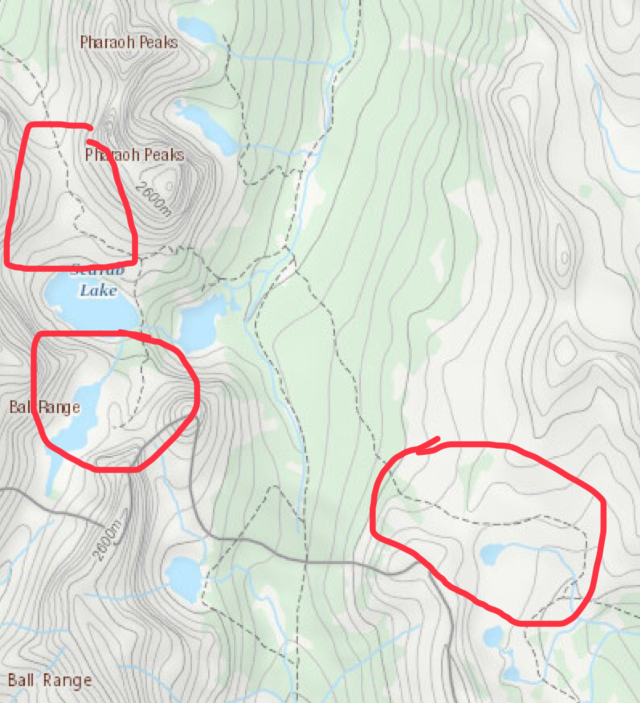
8) Temple Lake & Little Temple
Did somebody say ‘hidden gem’ or ‘most bang for your buck’. Both apply here. This is not a marked trail but more of a locals knowledge type of area. Along Moraine Lake Road, about half way up before making the 90 degree turn into the Valley of the 10 Peaks, park in an unmarked pullout on the left side of the road. From here, cross the road and follow the creek using faint trails gaining elevation all the way to Temple Lake (about 40 minutes). Larch trees are nested in at the lakes edge and Mt Temple’s famous East Ridge climb rises above in perfect symmetry. Stop here if you are not comfortable with route-finding, uneven terrain and significant elevation gain to continue on to Little Temple. If you continue follow the right shoreline of the lake to the back where you find a steep gully trending up and to the right, grassy for most of it. Reconsider if it is snow covered since coming down will be treacherous. Once reaching the top of the gully move out of it to the left to gain the saddle and then follow the ridge Eastwards to the top of Little Temple. Alternatively dive into the larches on the other side of the saddle that sprawl all the way down to Lake Annette in Paradise Valley. Lots of compositions are available using the hulking sight of Mt Temple as your background. Bring the ultra wide lens!
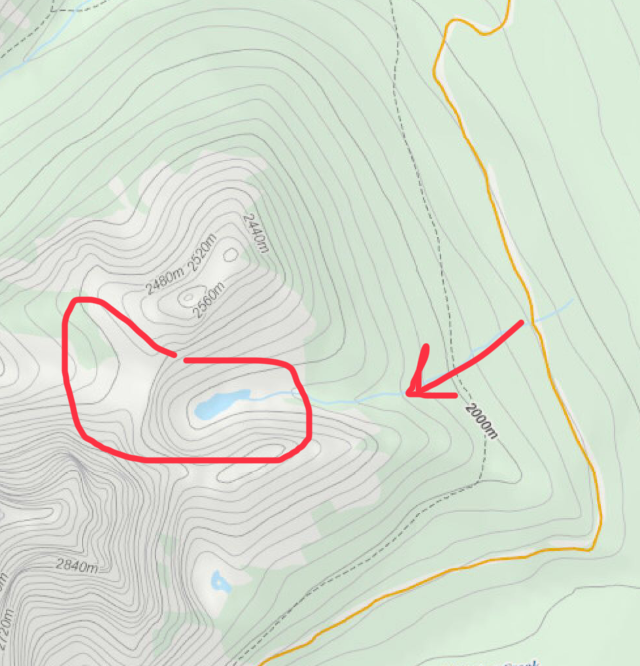
9) Tower Lake & Rockbound Lake
Park at the signed ‘Rockbound Lake’ car park at Castle Junction on the Bow Valley Parkway (half way between Banff and Lake Louise). It’s about a 6km hike to Tower Lake, and 8km to Rockbound which both lie in behind the iconic Castle Mountain. Larch trees ring the edges of these lakes. This must be done as a day trip as no camping exists in this area. If you have the stamina getting the top down view from higher up above Rockbound Lake is recommended. Find the faint trail at the outflow of the lake that ascends the scree cone and eventually breaking the cliff bands at their weakest point. This is a full day outing.
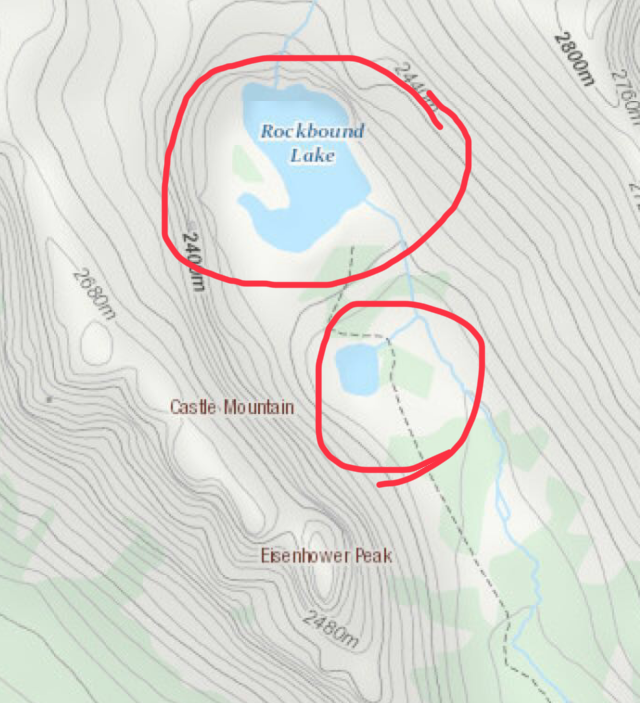
10) Fish Lakes
If you are the multi day backpacking type then Fish lakes should be on the radar in fall. I have yet to visit so will keep this short but suggest it if you have 2.5+ days on hand to explore and want to get off the beaten path then to do more research and let me know if you visit! It is on my list. The trail begins in Lake Louise (The Pipestone Valley trail) or if you get creative you can also access it from North Molar Pass via Mosquito Creek on the Icefields Parkway for an even more scenic route. Backcountry camping permits will need to be secured in advance – There are 5 sites only at Fish Lakes and I’ll bet they get booked up early.
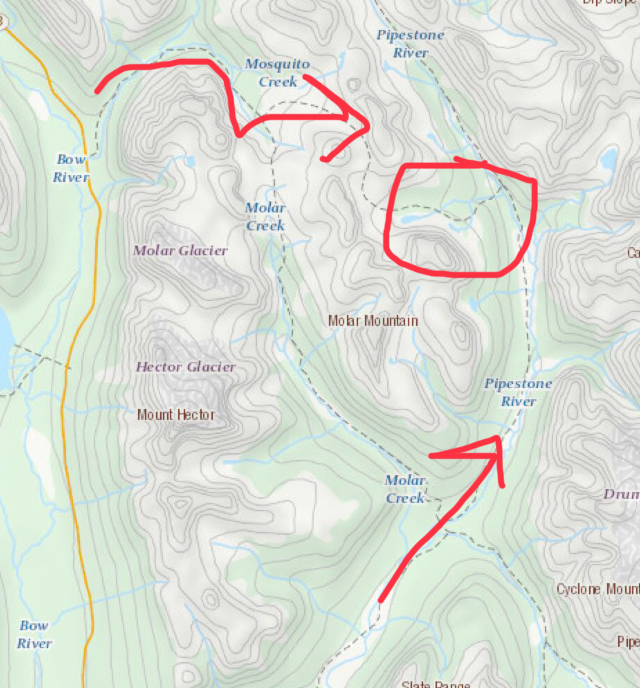
Note: All locations above are in Banff National Park. Some amazing locations exist in Kananaskis, Kootenay National Park, Yoho National Park & the Purcell Mountain range for photographing the alpine larch trees as well. Good luck!
Fun Fact: The alpine larch is one of the longest lived tree species in Canada!
Banff ‘trembling aspen’ fall photography guide
The other great tree to photograph in fall in the Banff area is the Trembling Aspen (populus tremuloides). These trees take less work to go and see as they occupy the same elevations as we do in the valley floors, front ranges and foothills of the Rockies. It is the most widespread tree in North America and when you see a stand of them together it is often just one tree connected underneath the ground via its roots. Below are some areas that you can go to to see these trees at their best in fall. I have extended this list beyond the borders of Banff as initial management practices of fire suppression within the park boundary has meant Banff has less of them than would naturally be the case. They peak in color from mid September through to the first week of October.
1) Muleshoe & Hillsdale meadows
Both of these quieter locations along the Bow Valley Parkway offer a welcome splash of color lower down in the valley in fall. Explore up close among the stands of trembling aspen trees and try your hand at some more intimate, abstract type photography working with color, texture and shape alone. A telephoto is helpful for this or getting in really close with your wider lenses. Hillsdale Meadows is more open and you can frame in some of the background peaks more easily but keep an eye out for the ‘Finger’ when at Muleshoe – a spectacular face of rock high above on the Sawback Range. The prescribed Sawback burn is in this area (seen on the right hand slopes beyond in the photo above) and its controlled burns like this that are the reason we see the aspens coming in around this area. It in turn attracts the wildlife – like Elk – to eat the shoots and bark, which in turn brings the wolves in. This is an example of the positive impact that fire has on the mountain environment.
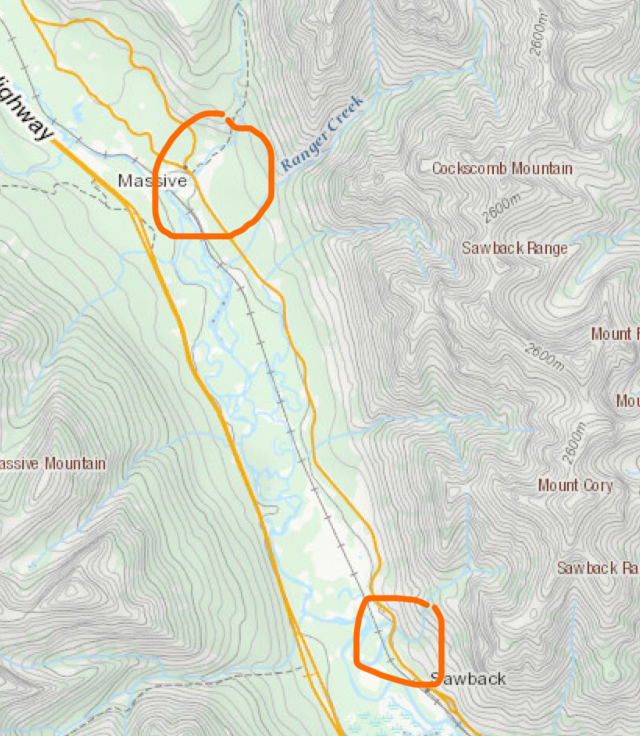
2) Canmore – The Alpine Club of Canada area
Park close to (but not at) the Alpine Club of Canada clubhouse in Canmore. There are spots along the entry road to park. Alternatively park in the Canmore Industrial area and walk over using the many trails. You couldn’t ask for a more spectacular backdrop in the the 3 Sisters mountains which really bunch up from this location. Exploring the hillsides using the trails will have you stumbling across pockets of golden trembling aspens throughout. These leaves begin to turn orange before dropping off so you have a fair bit of leeway when timing the aspen trees. Even fallen leaves on the ground is an excellent foreground.
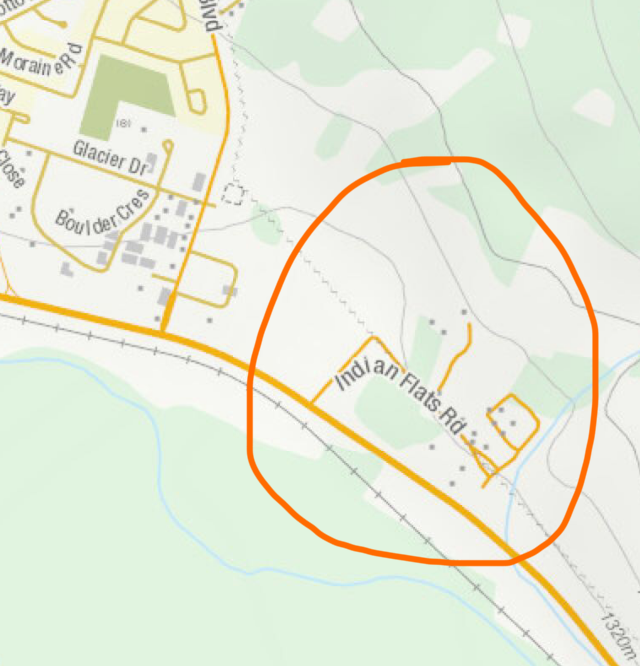
3) The front ranges – Yamnuska & Barrier Lake areas
All the way from the entrance to the mountains out towards Calgary is filled with Trembling Aspens, more than in the mountains proper. Yamnuska and Barrier Lake offer areas where you can combine this profusion of aspen trees with a mountain backdrop. For Yamnuska park along the 1A highway at the beginning of the hike up the mountain and explore from there – there are a number of small tarns and waterways in this area as well as wide open fields filled with fall color. Also close by, Bow Valley Provincial Park and ‘Middle Lake’ is an excellent spot where Yamnuska provides the backdrop to stands of trembling aspens. Barrier Lake is along the highway 40 into Kananaskis. Park near the dam wall or further along closer to Mt Baldy and explore from these spots. Alternatively load up the telephoto lens and head out towards Calgary and see what you can find and if you can compress the mountain backdrop into the fall color covering the foothills leading to the Rockies.
4) Fireside (Edith-Cory Loop)
On the closest end of the Bow Valley Parkway to Banff is the Fireside picnic area and this is where the Edith-Cory Loop trail begins. Not long into the trail and you enter the stands of Aspens which continue up the hillside for some way. It is a refreshingly short option close to Banff for some fall photography and the Sundance Range in particular works as a backdrop if you explore around here.
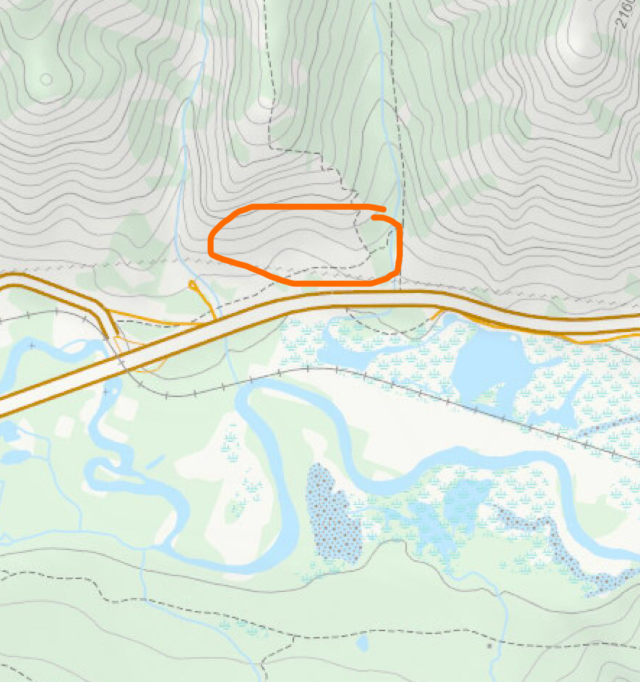
5) Preacher’s Point – Abraham Lake
Just outside of Banff National Park is Abraham Lake and at its Southern end is Preachers Point. Better known for the winter photography this spot has year round potential. Trembling aspens are thick in their stands at Preachers Point but also all along Abraham Lake. The wide open terrain allows you to frame up several peaks and ranges in the distance along with the aspens and the glacially colored, turquoise North Saskatchewan River flowing into the lake. On your way to get here (accessed via Saskatchewan River Crossing on the Icefields Parkway) you will pass by Waterfowl Lakes which also have some perfectly placed trembling aspens along its shoreline with Mt Chephren above. You should aim to shoot both spots!
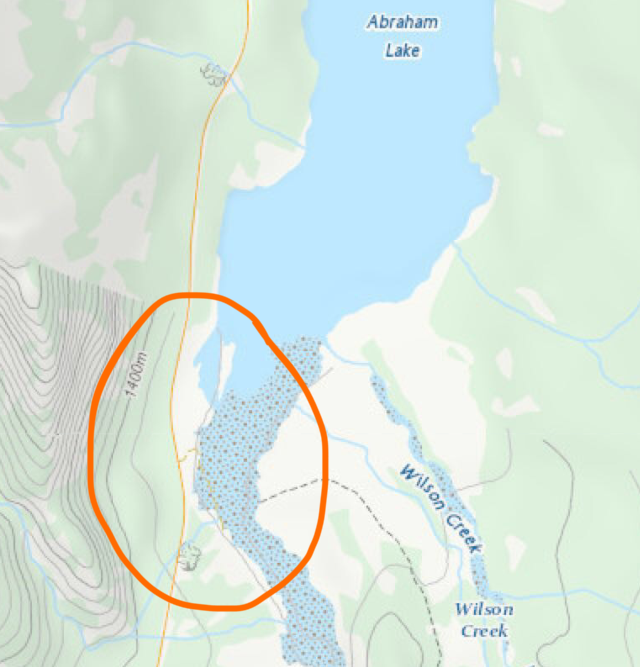
6) Lake Minnewanka – Aylmer Canyon Campsite
Beginning at Lake Minnewanka hike 8km around the edge of the lake until you reach Aylmer Canyon campsite (or use a kayak/canoe). There is a beautiful stand of trembling aspens at the campsite (LM8) area. It is one of my favourite areas to camp in Spring in the Rockies (pictured above). It should be spectacular in fall as well.
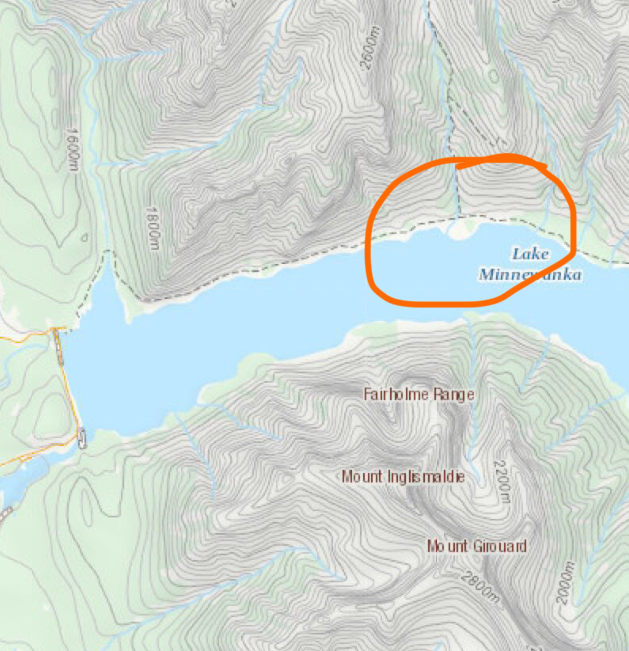
7) Icefields Parkway – Rampart Creek
Once you pass Saskatchewan River Crossing along the Icefields Parkway there is quite a lot of fall color/trembling aspen to photograph along the slopes of Mt Wilson near the Rampart Creek wilderness hostel (pictured above). It deserves a stop on the way to the Columbia Icefields or Jasper!
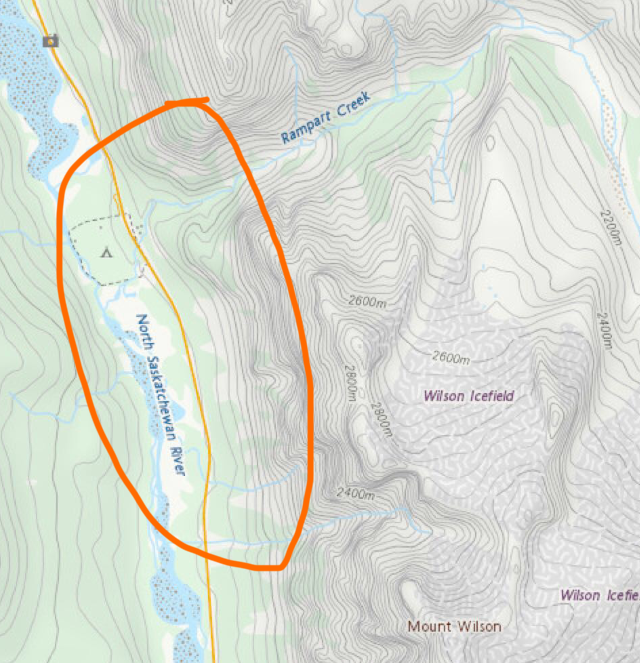
8) Kananaskis – Wedge Pond
Follow highway 40 along into Kananaskis until you reach the turn off for Wedge Pond. Mt Kidd stands tall above this lake ringed with trembling aspen trees. It is one of the easiest to reach and most beautiful fall photography spots in the Rockies. Go early and try to time it with mist/low hanging fog coming off the lake on a cold fall morning!
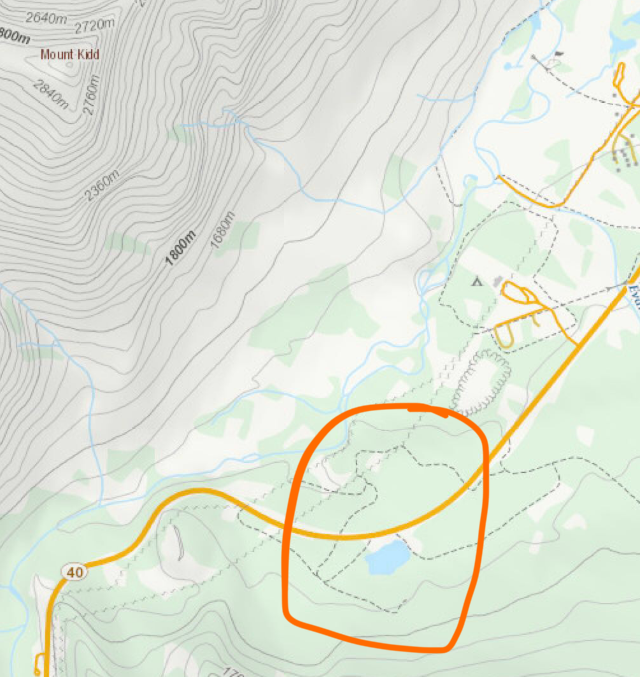
9) Canmore – Quarry lake, The reservoir & Carrot Creek
Right in Canmore surrounding Quarry Lake are some trembling aspen trees, same with the reservoir area which also has basalm poplar trees, which is also deciduous (pictured above right – park across from the entrance to the Nordic Centre) and they both provide you with the possibilities for reflections on a calm day. Ha Ling Peak and the Ehagay Nakoda Range are photogenic backdrops. If you are looking for something a little different, enter Banff National Park and shortly after the park entrance gates (the East gates just outside of Canmore) take the turn off on the right into a small parking area. This is Carrot Creek and you will already be surrounded by trembling aspens even before leaving your car. Take the nearby trail to find more!
10) Minnewanka Loop area
Right at the beginning of the Minnewanka Loop near Cascade Ponds is some clear areas with stands of trembling aspen. The Fairholme Range is a great mountain background to these scenes. The shoreline of Lake Minnewanka near the car park area also offers splashes of color which can be used to frame your scene nicely. As a bonus, exploring downhill from Johnson Lake (accessed form the Minnewanka Loop) towards Anthracite you might stumble across some basalm poplars, another deciduous tree in Banff National Park, which are also great in fall with Mt Rundle beyond. Watch for the coal mining scars along the way!
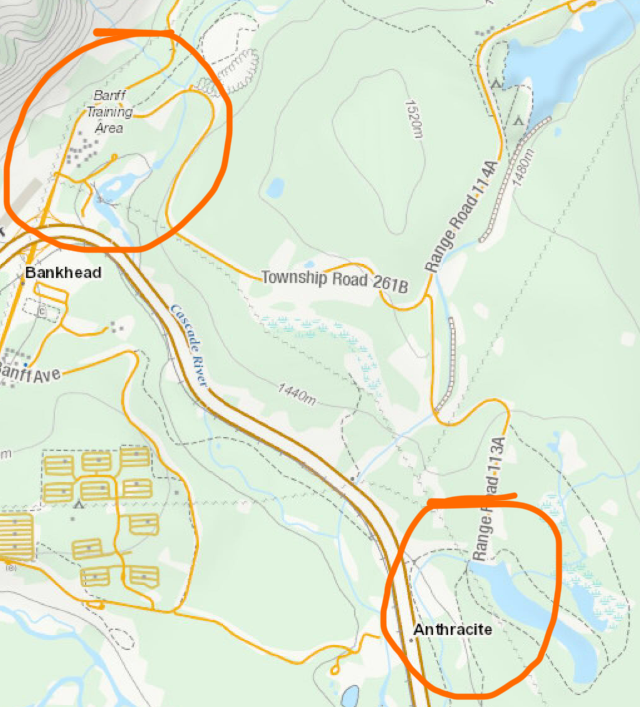
Note: Jasper National Park and the Jasper town area has more widespread trembling aspen stands than Banff so make sure to make a visit further North to see the colors there too.
Fun facts: Trembling aspens use their bark for photosynthesis & the heaviest/oldest organism on earth is a Trembling Aspen – it is in Fishlake National Forest, Utah and is called ‘Pando’.
Thanks for reading through this fall photography guide to Banff. If you are coming to Banff National Park in the future then sign up for our mailing list to hear about upcoming photography workshops and tours offered in the Canadian Rockies or contact me directly to arrange a custom photo tour based on your schedule;

